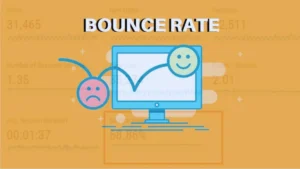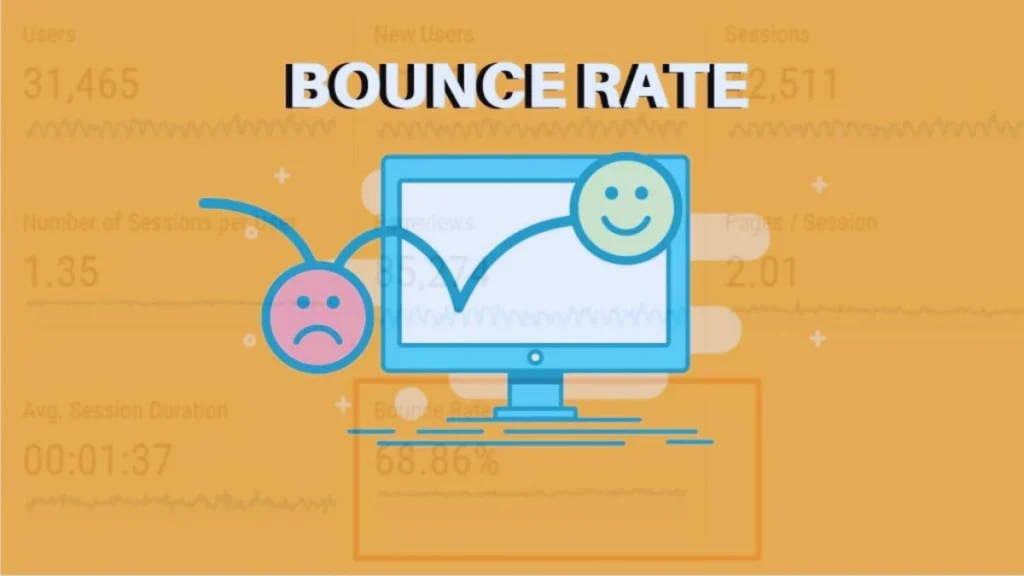Bounce Rate in Digital Marketing: Bounce rate is a crucial metric in digital marketing that helps measure user engagement and website quality. By understanding and analyzing bounce rate, marketers can gain insights into user behavior, improve website performance, and enhance overall digital marketing strategies. This article explores the concept of bounce rate, its importance, factors influencing it, and strategies to reduce it effectively.

Bounce rate is the percentage of visitors who navigate away from a website after viewing only one page. It is calculated by dividing the number of single-page sessions by the total sessions on the site. A high bounce rate indicates that users are not engaging with the website content, while a low bounce rate suggests better user interaction.
Reduce Bounce rate:
| Tip | Description |
| Improve Page Load Speed |
Optimize images, reduce server response time, and use caching to ensure faster load times.
|
| Enhance User Experience (UX) |
Ensure your website is easy to navigate with clear calls-to-action and mobile optimization.
|
| Create Engaging Content |
Provide high-quality, relevant content that captures attention and keeps visitors engaged.
|
| Use Internal Linking |
Include internal links to encourage visitors to explore more pages on your website.
|
| Optimize for Mobile |
Make sure your site is fully responsive and easy to use on a
|
Why Does Bounce Rate Matter in Digital Marketing?
The bounce rate is more than just a number. It provides key insights into how users engage with your content and whether your website meets their expectations.
- Search Engine Rankings: Search engines like Google consider bounce rates a signal of user satisfaction. High bounce rates may negatively impact your rankings.
- User Behavior Insights: Bounce rate highlights issues in your content or website design, helping you refine your approach.
- Conversion Potential: A lower bounce rate often indicates that users are engaging with your site, increasing the likelihood of conversions.
Key Factors Contributing to the High Bounce Rate
A high bounce rate often signals problems that need addressing. Here are the main culprits:
- Content-related Issues
- Irrelevant or low-quality content.
- Poor alignment with user search intent.
- Technical Problems
- Slow page loading speeds.
- Errors like broken links or non-responsive design.
- Design Challenges
- Cluttered or confusing layouts.
- Difficult navigation.
- Misleading Marketing
- Clickbait titles that fail to deliver promised content.
- Ads leading to irrelevant pages.
What is an optimal bounce rate?
The ideal bounce rate varies by industry. Here’s a benchmark:
- E-commerce websites: 20-45%
- Blogs: 65-90%
- SaaS: 35-55%
Compare your bounce rate with industry averages to gauge your site’s performance.
Strategies to Reduce Bounce Rate
Want to reduce your bounce rate? Here are actionable tips to keep visitors engaged:
- Improve content quality
- Craft relevant, engaging, and valuable content tailored to user intent.
- Break content into digestible sections with headings, bullet points, and visuals.
- Enhance Page Speed
- Compress images, leverage browser caching, and use a content delivery network (CDN).
- Tools like Google PageSpeed Insights can help identify issues.
- Optimize for Mobile Users
- Ensure a responsive design that provides a seamless mobile experience.
- Test for compatibility across various devices.
- Strengthen call-to-actions (CTAs)
- Use clear and enticing CTAs to guide users.
- Avoid overwhelming visitors with too many options.
- Internal Linking
- Provide links to related articles or product pages to encourage deeper exploration.
- Refine Targeting
- Use accurate keywords and ad placements to attract the right audience.
Tools to Measure and Analyze Bounce Rate
| Category | Tool/Resource | Purpose | Key Features | Link |
|---|---|---|---|---|
| Analytics Tools | Google Analytics | Track bounce rate and analyze user behavior. | Real-time tracking, audience insights, behavior flow reports. | Google Analytics |
| Hotjar | Visualize user behavior with heatmaps and recordings. | Heatmaps, session recordings, user feedback. | Hotjar | |
| Crazy Egg | Analyze click patterns and improve UX design. | Heatmaps, A/B testing, user insights. | Crazy Egg | |
| SEO Tools | SEMRush | Measure bounce rate alongside SEO metrics. | Competitive analysis, keyword insights, backlink tracking. | SEMRush |
| Moz Pro | Understand bounce rates in SEO context. | SERP rankings, on-page optimization metrics. | Moz Pro | |
| Performance Tools | Pingdom | Monitor website speed and performance. | Page speed analysis, downtime alerts. | Pingdom |
| PageSpeed Insights by Google | Analyze and improve website speed. | Mobile/desktop performance, Core Web Vitals. | PageSpeed Insights | |
| Feedback Tools | UserTesting | Gather user feedback on website design and usability. | Real user feedback, usability testing. | UserTesting |
| Learning Resources | Google’s Guide to Bounce Rate | Understand and analyze bounce rate basics. | Official guide from Google Analytics. | Google Support |
| HubSpot Blog | Learn strategies to reduce bounce rate. | Comprehensive blog on actionable tips. | HubSpot Blog | |
| Neil Patel’s Guide | Step-by-step guide to improving bounce rate. | Practical tips and examples for marketers. | Neil Patel Blog | |
| Yoast SEO Academy | Learn SEO techniques to reduce bounce rates. | Online course with SEO and UX lessons. | Yoast SEO Academy | |
| WordPress Plugins | MonsterInsights | Integrate Google Analytics with WordPress. | Easy analytics setup, real-time data insights. | MonsterInsights |
| WP Rocket | Optimize website speed for faster loading. | Page caching, image optimization, speed reports. | WP Rocket | |
| OptimizePress | Build user-friendly landing pages to reduce bounce rates. | Drag-and-drop builder, mobile-optimized designs. | OptimizePress |
How to Measure and Analyze Bounce Rate
Tools like Google Analytics make it easy to measure and analyze your bounce rate. Here’s how:
- Audience Overview: Track bounce rate trends across your site.
- Behavior Flow Reports: Understand the paths users take on your website.
- Landing Pages: Identify high-bounce pages to prioritize improvements.
Indicator of User Engagement and Website Quality
Bounce rate serves as an important indicator of how well a website engages its visitors. A high bounce rate may signal issues with content relevance, website design, or user experience.
Impact on SEO and Search Engine Rankings
Search engines like Google consider user engagement metrics, including bounce rate, as part of their ranking algorithms. A high bounce rate can negatively affect search engine rankings, reducing organic traffic and visibility.
Relation to Conversion Rates and User Satisfaction
A lower bounce rate often correlates with higher conversion rates, as engaged users are more likely to explore the site and take desired actions, such as making a purchase or filling out a form. Improving the bounce rate enhances overall user satisfaction and increases the likelihood of achieving business goals.
Factors Influencing Bounce Rate
Several factors can influence the bounce rate, including:
- Website Design and Usability: Poor navigation, cluttered layouts, and confusing interfaces can lead to high bounce rates.
- Content Relevance and Quality: irrelevant or low-quality content fails to capture user interest, resulting in users leaving the site quickly.
- Page load speed and performance: Slow-loading pages frustrate users and drive them away.
- Mobile friendliness and responsiveness: Websites that are not optimized for mobile devices can deter mobile users.
- User Intent and Behavior: Understanding why users visit the site and aligning content with their intent can reduce bounce rates.
Case Studies and Examples
Real-World Examples of Successful Bounce Rate Reduction
- E-commerce Site: An online store reduced its bounce rate by 20% by improving product page design and adding customer reviews.
- Blog: A content site decreased its bounce rate by 15% by optimizing page load speed and creating more engaging, multimedia-rich content.
Detailed Analysis of Specific Strategies Implemented
- Improved Navigation: Simplifying the site’s navigation improved the user experience and reduced bounce rates.
- Content Alignment: Aligning blog topics with user search intent resulted in higher engagement and lower bounce rates.
Common Mistakes to Avoid
Overlooking User Experience Issues
Neglecting user experience can lead to high bounce rates. Always prioritize usability and design.
Ignoring Mobile Users
With a significant portion of web traffic coming from mobile devices, ignoring mobile optimization is a costly mistake.
Failing to Update and Refresh Content
Stale and outdated content can drive users away. Regularly update your content to keep it fresh and relevant.
Misinterpreting bounce rate data
Avoid jumping to conclusions based on bounce rate alone. Consider other metrics and context to understand user behavior fully.
Future Trends in Bounce Rate Analysis
Emerging Trends in User Behavior and Website Engagement
- Increased focus on personalized user experiences.
- The growing importance of video content in reducing bounce rates.
Predictions for the Future of Bounce Rate in Digital Marketing
- Enhanced analytics tools provide deeper insights into user behavior.
- Integration of AI to predict and improve user engagement.
Conclusion
Bounce rate is a critical metric in digital marketing, reflecting user engagement and website quality. By understanding and optimizing bounce rates, businesses can improve user satisfaction, enhance SEO, and achieve better conversion rates. Regularly monitor bounce rate using analytics tools, implement strategies to reduce it, and stay updated with emerging trends to maintain a competitive edge in digital marketing.

